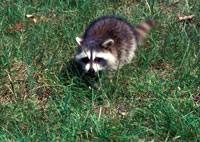Products to control raccoons are in our Yardener's Tool Shed; click here.
The name "raccoon" is derived from the Indian name Aroughcun. The familiar abbreviation "coon" is in general a colloquial use in the United States. The animal is common in wooded areas and possesses peculiar and interesting traits. Because of its abundance it can become a pest. Raccoons have become particularly comfortable in urban and suburban areas, feeding at night at man's garbage can restaurants. They range across most of the United States. They eat both plant and animal material of a wide variety and are active all year long in most parts of the country.
Why Raccoons Are A Problem
 |
You should never approach a raccoon no matter how cute you think it is. In parts of the U.S. raccoons represent a threat to pets because they carry the rabies virus. The rabies virus may be the most important reason for the homeowner not approaching a raccoon, particularly if it is traveling in daylight. If the raccoon is rabid, and the homeowner is bitten, you must take a series of injections that are painful to receive. If the raccoon does not run from you, call the local game protector and tell the person you suspect the raccoon in your yard may be rabid. A wild raccoon will run from a person if it is approached.
The second reason not to approach a raccoon is because they have a tendency to be mean-spirited when they think they are being cornered and their bite is very painful. Even tame raccoons will turn on the persons it is living with.
If you have a water garden, look out! They dine on fish, frogs, clams and crayfish with gusto. If you have problems with raccoons in your water garden, lay pieces of black sewer pipe in the pond to have a safe house for your fish. The pipe may need to be held down with some type of weight.
Most Obvious Symptoms of a Raccoon
If you have the following symptoms, you have raccoons:
Newly planted flowers or vegetables will be dug up over night. The plants are not eaten, but the roots are exposed to air.
Ears of corn, just ripe, will be either gone or lying on the ground, chewed up or partially eaten. Corn stalks are knocked down.
Melons will be broken, have a hole chewed through the rind, and partially eaten.
The coon's tracks look like the hand prints of babies. Their feces or scat are similar to cat's feces.

